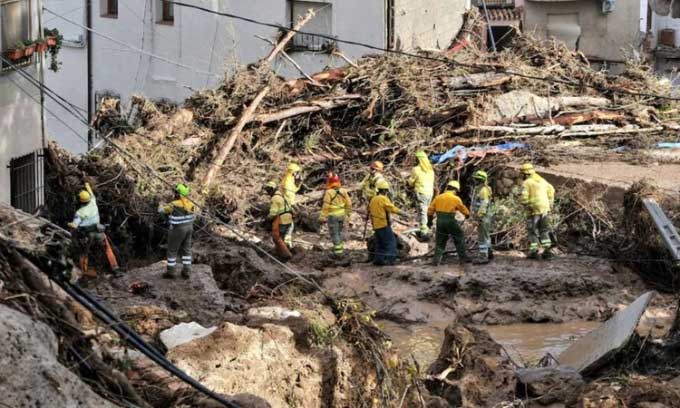The flash flood that claimed at least 95 lives in the Valencia region in 1996 was a consequence of climate change, hardened ground after summer, and the phenomenon known as a cold drop.
This was the deadliest flash flood in Spain since 1996, raising questions about the flood prevention measures necessary to cope with heavy rainfall that annually occurs in the fall in Valencia, according to Telegraph.

Rescue teams search for those trapped in the rubble after the flood in Letur, Albacete province. (Photo: Manu/PA-EFE).
Heavy rain poured down in the fall along the Mediterranean coast of Spain due to the “cold drop” phenomenon. This phenomenon occurs when warm, moist air from the Mediterranean encounters a sudden cold air mass from the north, resulting in localized heavy rainfall.
Valencia, located on the coast, is particularly susceptible to low-pressure systems at high altitudes in the fall due to the still-warm Mediterranean Sea. Such phenomena are not new, but they are becoming increasingly extreme due to human-induced climate change. Global warming caused by greenhouse gases retains heat and provides additional energy for storms. This means that when storms do occur, they will unleash greater forces.
The intensity of rainfall has quadrupled over the past 50 years in Spain, according to a recent study by the Polytechnic University of Catalonia, indicating an increase in heavy and intense rain. The threshold for heavy rainfall is defined as 60mm. During this cold air mass event, rainfall reached about 200mm, with some areas like the town of Utiel in Valencia experiencing up to 400mm.
Cold drops are extremely difficult to predict. Heavy rainfall does not always cause flash floods, but Valencia is particularly vulnerable. The likelihood of flash floods occurring is higher because after summer, the ground in Spain can become hardened and unable to absorb water. When heavy rain falls suddenly, water accumulates on the surface, exacerbating the risk of flash floods. Additionally, the rivers in Spain, especially in the Mediterranean basin, are relatively short and steep with narrow floodplains. Riverbeds fill up quickly, posing a threat to nearby communities. The urbanization of flood-prone areas also reduces natural absorption capabilities as soil is replaced with concrete. The drainage systems in Valencia are not designed to handle intense heavy rains. Despite efforts to modernize infrastructure, the area remains prone to flash floods. Research data indicates that similar disasters will occur more frequently and with greater intensity in the future.


















































